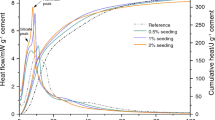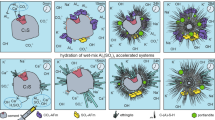Abstract
High energy mixing of calcium sulfate hemihydrate/water slurries provides a means to accelerate the hydration leading to gypsum formation. Additional benefits associated with high energy mixing include enhanced strength of the resulting gypsum casts. In order to exploit the advantages of high energy mixing, an understanding of the relationship between mixing energy and set acceleration is needed.
The present study investigated the relationship between a chemical accelerator and high energy mixing for the purpose of set acceleration. A mathematical model of this relationship allows calculation of the time to achieve 50% hydration given the added specific mixing energy, the percentage of added chemical accelerator by weight of stucco, and the water to stucco ratio for a given slurry. Use of this model along with experimental data allowed a comparison of the accelerative efficacy of mixing energy relative to chemical accelerator.
The results show that the accelerative capacity of high energy mixing is rather modest compared to that of the chemical accelerator, with a ten-fold increase in mixing energy required to maintain the same time to achieve 50% hydration when the chemical accelerator loading is reduced by 0.03%.
Résumé
Le mélange à haute énergie d'une suspension faite de sulfate de calcium semihydraté et d'eau permet d'accélérer l'hydratation qui mène à la formation du gypse. Un avantage supplémentaire du mélange à haute énergie est l'amélioration de la résistance des moulages. Afin d'exploiter ces avantages du mélange à haute énergie, une meilleure compréhension est nécessaire de la relation entre l'énergie de mélange et l'accélération de la prise.
Cette recherche étudie les relations entre l'accélération chimique et le mélange à haute énergie afin d'accélérer la prise. Un modèle mathématique de cette relation permet le calcul du temps nécessaire pour réaliser 50% de l'hydratation en fonction de l'énergie de mélange supplémentaire, le pourcentage d'accélérateur chimique ajouté par poids de plâtre, et le rapport eau/plâtre pour une suspension donnée. L'utilisation de ce modèle avec les données expérimentales permet de comparer l'efficacité de l'énergie du mélange par rapport à l'accélérateur chimique.
Les résultats montrent que la capacité d'accélération du mélange à haute énergie est relativement modeste par rapport à celle de l'accélération chimique. En effet, lorsqu'on réduit l'accélérateur chimique de 0,03%, dix fois plus d'énergie de mélange est nécessaire pour réaliser 50% de l'hydratation dans le même temps.
Similar content being viewed by others
References
Lefond, S. J., ed, ‘Industrial Minerals and Rocks’, 5th edn (AIME, 1983).
Karni, J. and Karni, E., ‘Gypsum in construction: Origin and properties’,Mater. Struct. 28 (1995) 92–100.
Ridge, M. J., ‘Mechanism of setting of gypsum plaster’,Rev. Pure and Appl. Chem. 10 (4) (1960) 243–276.
Lane, M. K. and Summerfield, J. M., ‘Effect of particle size of plaster on strength development of foamed casts’,Ceram. Bull. 54 (3) (1975) 291–303.
Ridge, M. J. and Beretka, J., ‘Calcium sulphate hemihydrate and its hydration’,Rev. Pure and Appl. Chem. 19 (17) (1969) 17–44.
Taplin, J. H., ‘Hydration kinetics of calcium sulphate hemihydrate’,Nature 205 (4974) (1965) 864–866.
Lewry, A. J. and Williamson, J., ‘The setting of gypsum plaster’,J. Mat. Sci. 29 (1994) 5279–5284.
Author information
Authors and Affiliations
Rights and permissions
About this article
Cite this article
Blaine, S. Accelerating the hydration of calcium sulfate hemihydrate via high energy mixing. Mat. Struct. 30, 362–365 (1997). https://doi.org/10.1007/BF02480687
Issue Date:
DOI: https://doi.org/10.1007/BF02480687




